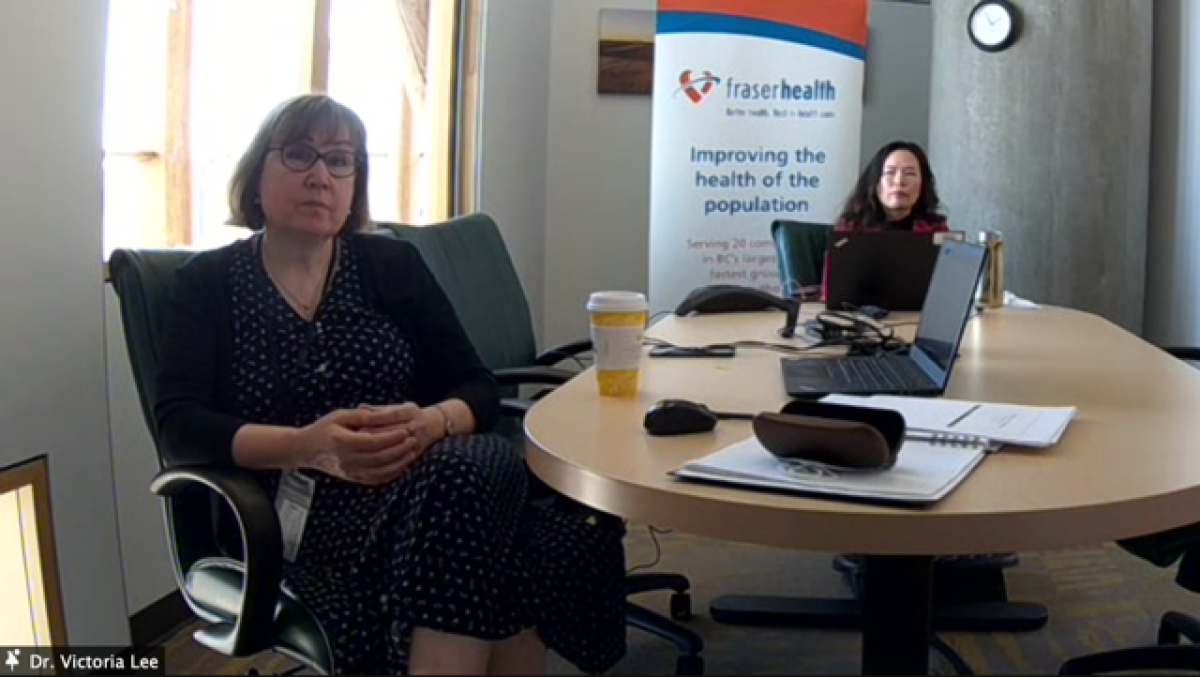밴쿠버 | [샌디 리 리포트] 빅토리아 리 박사 : 세계적인 유행병에서 "프레이저 패밀리"를 이끌고 있습니다.
페이지 정보
작성자 샌디 리 쪽지보내기 메일보내기 자기소개 아이디로 검색 전체게시물 작성일21-04-21 07:46 조회2,130회 댓글0건관련링크
본문


Victoria Lee 박사와 그녀의 최고 의료 보건 책임자 인 Elizabeth Brodkin 박사는 4 월 13 일에 버나비 무역위원회와 Q & A 세션을 가졌습니다.
빅토리아 이은형 박사는 BC에서 가장 크고 빠르게 성장하는 보건 당국 인 Fraser Health Authority의 사장 겸 CEO입니다. 그녀는 2018 년에 Adrian Dix 보건부 장관이 임명했습니다.
2020-2021 년 현재 연간 예산 약 40 억 달러, 직원 29,000 명, 의사 3,000 명, 자원 봉사자 6,000 이박사는 노스 웨스트 준주의 전체 예산과 인적 자원보다 더 광범위한 조직을 운영하고 있습니다. 그녀는 Fraser Health Authority에서 일하고 자원하는 거의 4 만 명의 사람들을 "The Fraser family"라고 부릅니다.
이 박사는 존스 홉킨스 대학교에서 공중 보건 및 경영학 석사 학위를 취득한 의사로, 수석 의사에서 CEO가되는 비정상적인 도약을 설명합니다. Fraser Health에 입사하기 전에 그녀는 칠레와 브라질의 시골 지역에서 여행 의사로 일했습니다. 그리고 유엔과 세계 은행을 위해.
전염병이 닥칠 때까지 그녀의 초점 중 하나는 해당 지역의 아편 유사 제 위기를 해결하는 것이 었습니다. 이제이 박사는 한 세기에 한 번의 세계적인 유행병을 통해 그녀의 "Fraser 가족"을 이끌고 있습니다. 그녀는 그들이 첫 번째와 두 번째 물결에서 곡선을 구부리고 그들의 건강 관리 시스템을 보호 할 수 있다는 사실을 자랑스럽게 생각합니다. 세 번째 물결은 그녀에게 더 심각한 도전을주고 있습니다.
Fraser Health는 32 개의 First Nations와 5 개의 Metis Chartered 커뮤니티의 원주민 62,000 명을 포함하여 Fraser Canyon의 Boston Bar부터 Burnaby 및 Delta의 밴쿠버 교외에 이르기까지 22 개 지자체의 180 만 명의 건강 관리 요구를 돌보고 있습니다. 캐나다에 새로 온 사람들이 그곳에 정착합니다.
세계 보건기구 (WHO)가 작년에 Covid-19를 세계적인 유행병으로 선언 한 이후 Fraser Health는 총 수와 1 인당 기준으로 BC 주에서 가장 높은 64,000 건 이상의 사례를 기록했습니다. 그 이유는 간단합니다. 고위험 산업, 농장, 식품 가공 공장, 제조 부문 및 대형 창고가 밀집된 고밀도 환경의 많은 인구입니다.
Brodkin 박사에 따르면 문화적으로 다양하고 밀집된 인구도 추가 문제를 제기합니다. "Fraser Health 지역은 인구가 많고 인구 밀도가 높기 때문에 여러 세대에 걸쳐 지역 사회, 가정 내에서 사람들이 밀접하게 함께 살고 있습니다."
Fraser Health는 지역 전역에 22 개의 예방 접종 클리닉을 개설 한 다음 인기가 입증 된 원주민 고객, 팝업 클리닉 및 드라이브 스루 클리닉을 위해 문화적으로 안전한 전문 클리닉을 추가했습니다.
이 박사에 따르면 클리닉 시간과 하루 종일 백신 접종은 문제가되지 않습니다. "시간이나 용량이 아닙니다. 기존 클리닉에 더 많은 라인을 추가 할 수 있습니다. 그들은 하루 종일 투여 량을 처리 할 수있는 강력한 시스템을 가지고 있습니다. 남은 백신이 거의 없으며 우선 순위 그룹이 이미 확인되었습니다. 이 모든 것이 가장 잘 실행되는 시스템 중 하나입니다. 엄청난 양의 긍정적 인 피드백을 받았습니다. "
문제는 백신 부족입니다. Fraser Health는 대부분 대량 백신 클리닉에서 매일 약 10,000 ~ 15,000 회 백신을 투여하고 있습니다. 그리고 일부는 약국에서.
그들은 설립 된 클리닉 내에서 하루에 최대 20,000-23,000 회 투여 할 수 있습니다. 문제는 백신의 안전한 공급이 부족하다는 것입니다. 화이자는 신뢰할 수있는 도구 였지만 Moderna는 상당히 다양했습니다. Astra-Zeneca는 보관 및 운송이 더 쉽기 때문에 약국으로 이전했습니다.
이 박사는 인구에 기반한 비율을 넘어서는 사례 량을 기반으로 더 많은 백신이 프레이저 헬스에 올 수 있도록 로비하고 있습니다. 그러나 그녀는 백신 부족과 긴급한 필요의 국가적 벽에 맞서 싸우고 있습니다.
BC는 현재 예방 접종 프로그램에서 연령대, 고위험군 및 발병 흐름의 세 가지 흐름에 따라 작업하고 있습니다.
발병 흐름의 가장 두드러진 사례는 휘슬러와 프린스 루퍼트에서 발생하여 두 지역 사회에서 18 세 이상의 모든 적격자에게 예방 접종을하도록했습니다.
Surrey는 Fraser Health 지역에서 확산의 진원지입니다. 그러나 한 번에 예방 접종을하기에는 너무 커서 당국은이를 위해 필요한 수십만 개의 백신을 보유하고 있지 않습니다.
이 분야의 사람들을 위해 Lee 박사는 가능한 한 Astra Zeneca 백신을 맞도록 권장합니다. 그녀는 그것이 안전하고 효과적인 백신이라고 확신합니다. BC는 이제 브레이크 아웃 스트림의 수정 된 버전 인 일부 지역 사회에 대해 Astra Zeneca 백신의 적격성을 40 세로 낮추었습니다.
Astra-Zeneca 백신이 드물게 발생하는 혈전으로 문제가 발생하기 전에 Fraser Health는 고위험 스트림 백신 프로그램에 이 백신을 사용했습니다. 농장 및 식품 가공 공장과 같이 Covid-19 위험이 높은 부문이 가장 먼저 예방 접종을 받았습니다.
그들은 수백 수천 명의 사람들이 실내에서 일하는 FedEx, Amazon 및 Safeway와 같은 대기업 소유의 대형 창고 및 제조업의 다른 고위험 작업장에서 계속해서 예방 접종을 받기를 희망합니다.
이 박사는 여러 가지 이유로 "우리는 지금까지 경험 한 대유행 중 가장 어려운 부분에 있습니다"라고 말합니다. Covid 피로가 있으며 우리는 다양한 우려 사항과 사례 수로 인해 매우 어려운 위치에 있습니다.”
우리는 병에 걸린 사람들이 더 젊어지고 있다는 증거가 증가함에 따라 한 사람에서 다른 사람으로 더 쉽게 전염되는 우려의 변종이 도래하면서 세 번째 물결에 접어 들고 있다고 Brodkin 박사는 말합니다.
겉으로보기에 어려운시기는 당분간 계속 될 것입니다. 이주는 4 월 26 일부터 더 엄격한 여행 제한을 받게됩니다.

Dr. Victoria Lee: Leading the "Fraser Family" in a global pandemic.
Dr. Victoria Lee, and her Chief Medical Health Officer, Dr. Elizabeth Brodkin, held a Q & A Session with the Burnaby Board of Trade on April 13th.
Dr. Victoria Eun Hyung Lee is the President and CEO of Fraser Health Authority, the largest and fastest-growing health authority in BC. She was appointed to her position by Health Minister Adrian Dix in 2018.
With its annual budget of almost 4 billion dollars and 29,000 employees plus 3,000 doctors and 6,000 volunteers as of 2020-2021, Dr. Lee runs an organization more extensive than the entire budget and human resources of Northwest Territories. She calls the almost 40,000 people who work and volunteer for Fraser Health Authority "the Fraser family."
Dr. Lee is a doctor with a post-graduate degree in Public Health and Business Administration from Johns Hopkins University, which explains her unusual jump from being the chief doctor to becoming the CEO. Before joining Fraser Health, she worked as a travel doctor in rural areas of Chile and Brazil; and for the United Nations and World Bank.
Until the pandemic hit, one of her focuses was on tackling the opioid crisis in her region. Now, Dr. Lee is leading her "Fraser family" through the once-in-a-century global pandemic. She’s proud of the fact that they were able to bend the curve in first and second wave and protect their health care system. The third wave is giving her a more serious challenge.
Fraser Health looks after the health care needs of 1.8 million people in 22 municipalities, from Boston Bar in the Fraser Canyon to the Vancouver suburbs of Burnaby and Delta, including 62,000 indigenous people in 32 First Nations and 5 Metis Chartered communities, and many refugees and newcomers to Canada settle there.
Since the World Health Organization declared the Covid-19 a global pandemic last year, Fraser Health has had more than 64,000 cases, one of the highest in BC, in total numbers and on per capita base. The reasons are simple: a large population in high density environment with a concentration of high-risk industries, farms, food processing plants, manufacturing sectors and large warehouses.
The culturally diverse and dense population pose extra challenges too, according Dr. Brodkin. "The Fraser Health region has a large population and dense population where people live closely together, in communities, within households, multigenerational.”
Fraser Health opened 22 vaccination clinics across the region and then added specialty clinics that are culturally safe for indigenous clients, pop-up clinics and drive-through clinics which proved popular.
According to Dr. Lee, the clinic hours and the end-of-the-day vaccine doses are not the problem. "It's not the hours or capacity; they can add more lines to existing clinics. They have a robust system to deal with the end-of-the-day doses. There are minimal vaccines left over, and they have priority groups already identified. All of those are in place—one of the most well-run systems. They've had a massive amount of positive feedback."
The challenge is the vaccine shortage. Fraser Health has been administering about 10,000 to 15,000 doses of vaccines every day, mostly in mass vaccination clinics. And some in pharmacies.
They can run up to 20,000 to 23,000 doses per day within established clinics. The problem is the lack of a secure supply of vaccines: Pfizer has been a reliable workhorse, while Moderna has varied quite a bit. Astra-Zeneca has moved out to pharmacies because they are easier to store and transport.
Dr. Lee has been lobbying for more vaccines to come to Fraser Health based on the caseload beyond the proportion based on population. But she's fighting against the national wall of vaccine shortage and acute needs.
BC is currently working under three different streams in their vaccination program: Age stream, high-risk sectors stream and the outbreak stream.
The most prominent example of the outbreak stream happened in Whistler and Prince Rupert, forcing the province to vaccinate every eligible person over 18 years old in the two communities.
Surrey is the epicentre of the spread in the Fraser Health region. But it's too big to vaccinate all at once, and the Authority doesn't have hundreds of thousands of doses of vaccines it will take to do that either.
For people in these areas, Dr. Lee encourages them to take Astra Zeneca vaccines when they can. She assures us it is a safe and effective vaccine. BC has now lowered the eligibility for the Astra Zeneca vaccine to 40 years old for selected communities, a modified version of the breakout stream.
Before the Astra-Zeneca vaccine ran into trouble with rare cases of blood clots, Fraser Health was using it for their high-risk stream vaccination program. The sectors with high Covid-19 risks, such as farms and food processing plants, were among the first to be vaccinated.
They hope to continue to vaccinate workers in other high-risk workplaces in manufacturing and large warehouses owned by big businesses, such as FedEx, Amazon and Safeway, where hundreds and thousands of people work indoors.
Dr. Lee tells us "We are at the most difficult part of the pandemic that we've experienced thus far," for many reasons. There is Covid fatigue, and we are in a very tough spot with the variants of concern and the number of cases.”
We are in the third wave with the arrival of the variants of concern, which transmit more easily from one person to another with increasing evidence that people who become sick are younger are getting sicker, says Dr. Brodkin.
By all appearance, the difficult times will continue for a while. The province will be under more stringent travel restrictions starting April 26th.
댓글목록
등록된 댓글이 없습니다.






